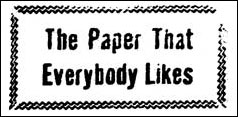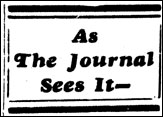Less than two weeks after war was declared the Journal announced its intention to change its format. To better cover the war news, it would be published daily. "History is in the making every hour of the day; events of tremendous importance are taking place. Distance really means little in this age; the whole earth is a closely inter-dependent neighbourhood - it is essential that we, even here in pastoral Prince Edward Island, should constantly be in touch with what is transpiring in the World at large."
An editorial reprinted from the Bridgetown, Nova Scotia newspaper in August 1940 noted, "We do not know of the experiment of operating a daily paper in any other town in Canada of the size of Summerside" and offered praise for its quality of columns.
In October 1940, the Journal asked its readers to send in details about men from Summerside and Prince County who were enlisted in any branch of the Canadian armed forces. Pertinent facts regarding rank, regiment, and names of family members were requested along with photographs. "It is the intention of the Daily Journal to print the photographs and other information about our soldiers and thus make a permanent record of the lives of these brave men who have answered the call for help in Canada's darkest hour."
As a follow-up to the request, a special two-page spread appeared on November 9 under the headline "These Island Boys are with the Canadian Forces." It was noted that more photos and information would be published in future issues. For weeks afterwards, these tributes appeared in the paper.
The Journal constantly strived to give broad coverage of the latest news and offered solid opinions on various issues. It published many editorials over the war years about the important role Islanders could play on the home front. A lengthy editorial in October 1941 about "The Influence of the Newspaper" acknowledged the power of the press to sway its readers.
At the end of 1941, daily publication ceased and the Journal became a semi-weekly with issues appearing every Monday and Thursday beginning Monday 5 January 1942. The next practical change that took place wasn't until October 1945. By that time the war was over and the decision was made to move the foreign news from the front page to the back page and the local news was expanded to cover page one as well as the usual page three.
A special souvenir issue of the Journal marked the first anniversary of the No. 9 School in December 1941 and thereafter there was a special issue devoted to the Royal Canadian Air Force every December. Each had extensive articles about RCAF Station Summerside and provided an opportunity for local firms to thank the Station personnel for their patronage.
The Journal also issued special editions to promote the Victory Loan campaigns. The one published in October 1943 received praise from The Canadian Weekly Newspapers Association Bulletin. It remarked on the excellent job that newspapers across Canada were doing to support the drive. "We have seen some outstanding editions and hesitate to single out any for special mention. However, we think, The Summerside (PEI) Journal's 32 page tabloid tops everything received at central office to date. The Victory Loan flag is prominently displayed on the front page and most of the display advertisements are in two colors."
The Journal did not hesitate to praise itself. One particular item of note was published to mark its 78th birthday in the fall of 1943. Under the title "The Paper That Everybody Likes" the article outlined the paper's history and its current status, summing up with a catchy verse. The editor had a penchant for composing verses or one-liners that reflected the mood around town. He began a column called "As the Journal Sees It" in February 1943. The column continued to be a regular feature on the second page until 1951. Its purpose was summed up via a verse in the column of 23 December 1943. View a Sampling.
| Related Articles | Related Images | Related Memories | Related Websites | Inflation Calculator |
| Home Page | Site Map | Contact Us | Wyatt Heritage Properties |







